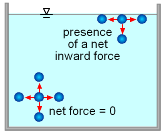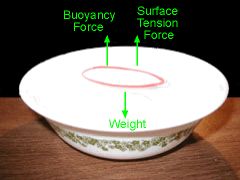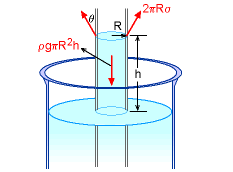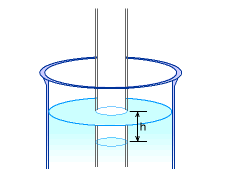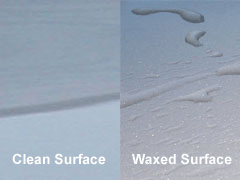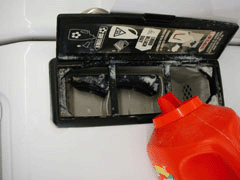| Ch 1. Basics | Multimedia Engineering Fluids | ||||||
|
Mass Density |
Ideal Gas Law |
Viscosity |
Surface Tension |
Vapor Pressure |
|||
| Surface Tension | Case Intro | Theory | Case Solution |
| Chapter |
| 1. Basics |
| 2. Fluid Statics |
| 3. Kinematics |
| 4. Laws (Integral) |
| 5. Laws (Diff.) |
| 6. Modeling/Similitude |
| 7. Inviscid |
| 8. Viscous |
| 9. External Flow |
| 10. Open-Channel |
| Appendix |
| Basic Math |
| Units |
| Basic Fluid Eqs |
| Water/Air Tables |
| Sections |
| eBooks |
| Dynamics |
| Fluids |
| Math |
| Mechanics |
| Statics |
| Thermodynamics |
| ©Kurt Gramoll |
|
|
|||||||||||||||||||||||||||||||||||||||
|
In this section, the concepts of cohesion and adhesion will be
introduced, followed by a discussion of surface tension. |
|||||||||||||||||||||||||||||||||||||||
|
Table: Surface Tension of Water in
2nd ed., New York, 1994.) |
Surface Tension |
||||||||||||||||||||||||||||||||||||||
|
From physics, it is known that molecules are attracted to each other through molecular forces. The force attraction between like molecules (e.g., molecules within a liquid) is called cohesion. The attraction between unlike molecules (e.g., molecules between liquid and solid) is called adhesion. As noted in the figure at the left, the net cohesive force exerted on a molecule inside a liquid is zero; whereas there is a net inward cohesive force exerted on a molecule at the surface. As a result, this inward force holds the liquid together and forms a definite volume. In addition, the liquid surface acts like a thin stretched membrane. For example, a rubber band, which is denser than water will float on water. The weight of the rubber band is balanced by the force created by the surface tension of the water and the buoyancy force. The force exerted on the liquid surface per unit length is referred to as the surface tension and is denoted by the Greek symbol σ. In other words, surface tension is the force (per unit length) required to change the surface shape of the liquid. The SI unit for the surface tension is N/m and the English unit is lb/ft. Surface tension is a fluid property and is generally a function of temperature and the medium in contact with the fluid. The surface tension of water in contact with air is summarized in the table to the left as a function of temperature. The table below gives the surface tension for various liquids with air.
|
|||||||||||||||||||||||||||||||||||||||
| Surface Tension - Capillary Action |
|||||||||||||||||||||||||||||||||||||||
|
Surface tension can also be observed through the rise and fall of liquid in a capillary glass tube. Consider a liquid in contact with glass. If the adhesion between the liquid and glass is greater than the cohesion of the liquid molecules, then the liquid rises up the tube. The liquid is said to wet the glass surface. On the other hand, if cohesion is greater than adhesion, then the liquid falls in the tube, and it does not wet the surface. The rise and fall of liquid in small diameter tube is referred to as capillary action. For example, water wets a clean surface but tends to form droplets while in contact with a waxed or greasy surface. On the other hand, mercury does not even wet a clean glass surface because of its high surface tension. Consider the rise of a water column in a small-diameter tube. The height of the rise (h) can be obtained by a force balance (i.e., the vertical component of the force created by surface tension must be balanced by the weight of the liquid column), 2πRσ cosθ = ρgπ R2h which can be simplified to yield h = 2σ cosθ / (ρgR) where θ is the contact angle or wetting angle and σ is the surface tension (N/m, lb/ft). For wetting liquids, θ is less than 90°; for non-wetting liquids, θ is greater than 90°. For example, the contact angle is zero for water with a clean glass whereas the contact angle is 130° for mercury with a clean glass. The surface tension of a liquid can be altered by a surfactant (surface active agent). Take detergent for an example. Detergent is used to reduce the surface tension of water so that water is more likely to wet the surfaces of clothing for cleaning. |
||||||||||||||||||||||||||||||||||||||
Practice Homework and Test problems now available in the 'Eng Fluids' mobile app
Includes over 250 free problems with complete detailed solutions.
Available at the Google Play Store and Apple App Store.
